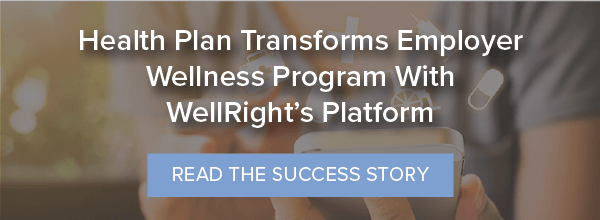
Health plans rely on an understanding of member needs to create interventions that improve population health. That presents a challenge in the best of circumstances, but the pandemic added another nuance—delayed care.
While they were actively involved in providing access to the information, vaccinations and care members needed to prevent and treat COVID, health plans lost valuable insight into the health needs of their members … because routine checkups and tests were put on the back burner.
The issue of delayed care isn’t new; we live in a society that exalts being busy. Even before the pandemic, people struggled to make time to eat healthy meals and stay active, let alone schedule medical appointments.
Now there are new challenges. The health care industry is suffering from a serious worker shortage, which has changed office workflows and limited appointment availability. A member who used to be able to walk into the pharmacy for a flu shot now has to wait up to two weeks for an appointment.
People aren’t as quick to resume regular doctor appointments, many are still afraid to go to the doctor’s office, and even more have become complacent about their symptoms.
“People often don't seek care because they don’t realize their condition is deteriorating until symptoms develop—and then oftentimes it’s too late,” says Dr. Lawrence Kosinski, founder and chief medical officer for SonarMD, a digital solution that helps coordinate care for complex chronic diseases. “Take Crohn’s disease, for example. Patients are so used to living with their symptoms that they don’t realize they’re getting worse until they wind up in the ED.”
Delaying care also has a negative impact on employers. When employees become ill, employers not only take on the cost of care (through partially- or fully funded benefit plans), but they can also lose valuable resources. That means more costs allocated to finding temporary replacements and training them, that is, if a company can find them.
COVID and the “great resignation” have made it more difficult for companies to hire and retain employees, contractors and temporary staff. When they do find people, the bonuses and other costs associated with bringing them on can be exorbitant.
Health plans need a way to engage directly with members to regain insight into their health needs and deliver the evidence-based medical information that can help close gaps in care.
All of this can be accomplished with the right wellness platform.
Related Content: Top 5 Member Wellness Program Features Health Plans Need to Consider
A Wellness Platform Makes Member Engagement Easier
Engagement is one of the greatest challenges in population health, especially now that people have become more reluctant to share personal information. If a member is particularly concerned about a symptom, their fear of what it could be may make them even less likely to share what’s happening.
Members need to have a sense of trust. Using a wellness platform that looks and feels like the rest of your digital offerings can make engagement easier.
Integrate With Existing Technology to Promote Adoption
Integrating with existing technology, customizing and white-labeling: All these features create a seamless experience that can be deployed to employer groups, providers and members. Not only does it create more engagement between health plans and members, it also creates more connection within the health care ecosystem.

– LouAnne Giangreco, MD FACEP, Chief Medical Officer at WellRight
Offer Multiple Channels for Engagement
A great wellness platform can create an omnichannel experience that combines text messages, social media, mobile apps, and internal company apps to communicate with members. It should also offer a multitude of ways to engage members:
- Interactive wellness challenges ranging from general health to biometrics to symptom or well-being tracking.
- Individual and team activities that create connection within organizations and set up peer-driven engagement.
- Integration with other health and wellness apps and offerings, such as Apple Health and Withings health monitoring devices.
- Incentivized surveys that establish baselines to determine the type of content members need to make informed decisions about their health and care.
A Wellness Platform Keeps Members Informed and Proactive
Once health plans engage members, they can deliver evidence-based, best practice content that is fun and engaging. Wellness platforms make it easy to create customizable content based on well-being and prevention programs as well as existing disease management or complex care management programs.
Promote Educated Decision Making
Your wellness platform can be used to inform members, dispel myths, and promote smart health care choices, such as knowing when to seek urgent versus emergent care—a decision that accounts for tremendous overspending in the health care industry.

– LouAnne Giangreco, MD FACEP, Chief Medical Officer at WellRight
Address Disease Management and Complex Care Management
It’s important to address the lingering perception that wellness programs are solely for people who already enjoy good health and are just looking to improve their physical fitness or lose a few pounds. A strong wellness program will also be relevant for people with acute illnesses, chronic illnesses, acute on chronic illnesses, and advanced chronic diseases, offering programming across the entire spectrum of wellness.
Many health plans use biometric health screening and health risk assessments to determine who can benefit from disease-specific programming. If a member is identified as having a high risk for heart disease—either because of family history or personal habits—they can be automatically enrolled in activities, challenges, and content distribution for stroke or heart attack prevention programs. On the other hand, if the member has already been diagnosed with a chronic condition, they can get information specific to that disease.
Nearly all health plans have a relevant health and wellness content, including prevention programs that include blogs, newsletters, guides, webinars and other curated content. Sharing those resources in a static environment is fine, but members have a better chance of learning and adopting better habits when that program is delivered as an incentivized activity or challenge.
Support Employer Initiatives and Address Challenges
And what of programming created by employers? Health plans can add value there too.
Every employer has content they want to feature and gaps they want to fill. A wellness platform allows health plans to fill those gaps and integrate content specific to each member company.

– LouAnne Giangreco, MD FACEP, Chief Medical Officer at WellRight
Tools, such as incentives, activities and challenges only increase program success. So does data.
A Wellness Platform Delivers Indispensable Data
Using a wellness platform strengthens the data capabilities and reporting that health plans can use and offer to clients. Specifically, it allows health plans to:
- Measure member engagement across the platform to glean trends by a number of factors, which helps inform programming changes.
- Measure member engagement by employer group to empower better marketing and messaging within those companies.
- Capture essential health information to understand the types of programming needed and the overall health needs of their member population.
- Integrate all data files into population health databases in support of initiatives within the plan and across the ecosystem.
- Construct reports to demonstrate the ROI and VOI of the program to health plan leadership and employer group client leadership.
Engaging members is a challenge for health plans, but they don’t have to do it on their own. Leveraging a wellness platform can get health plans on track to achieve their goals and improve the health and well-being of their members.
Find out how WellRight has helped other health plans use wellness platforms to deliver more value to their employer clients and help improve wellness for all of their members. When it comes to employee wellness, health and well-being, we’re here to help.




